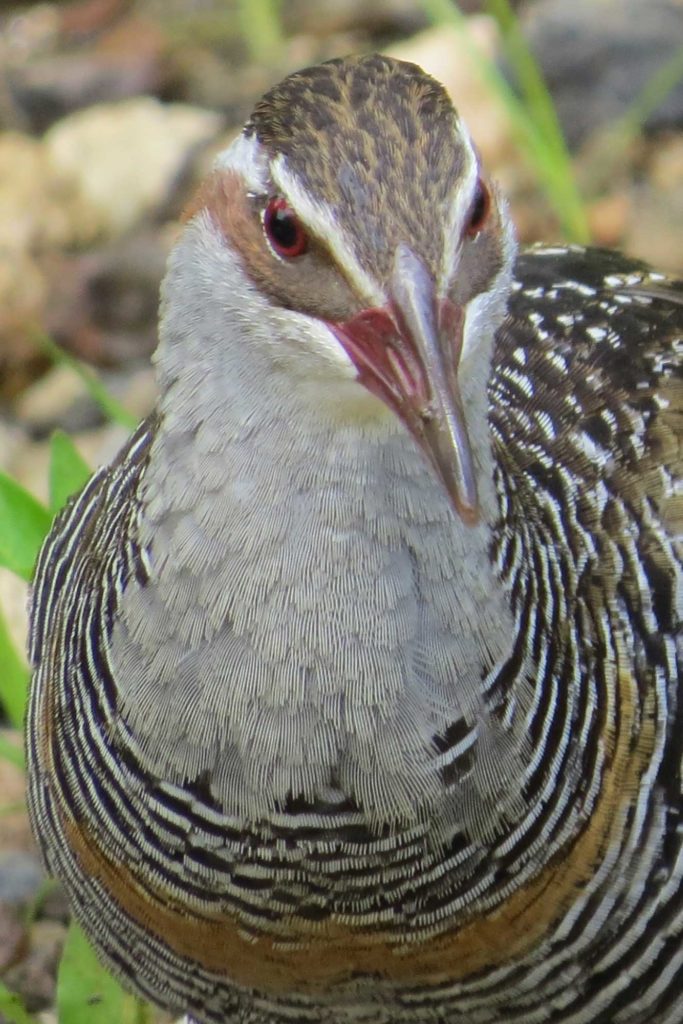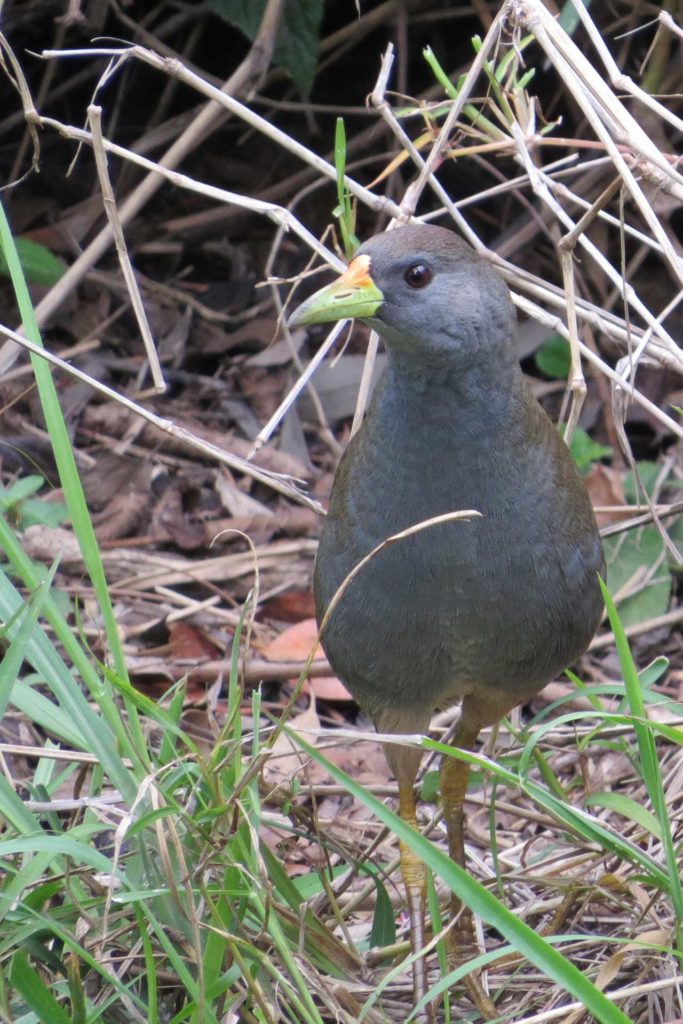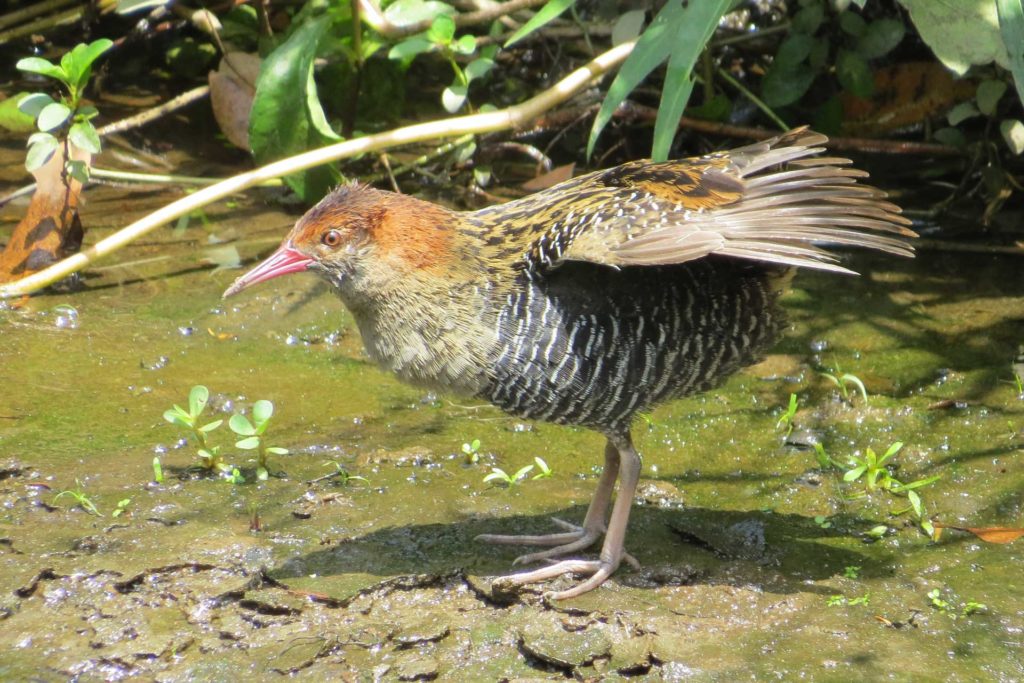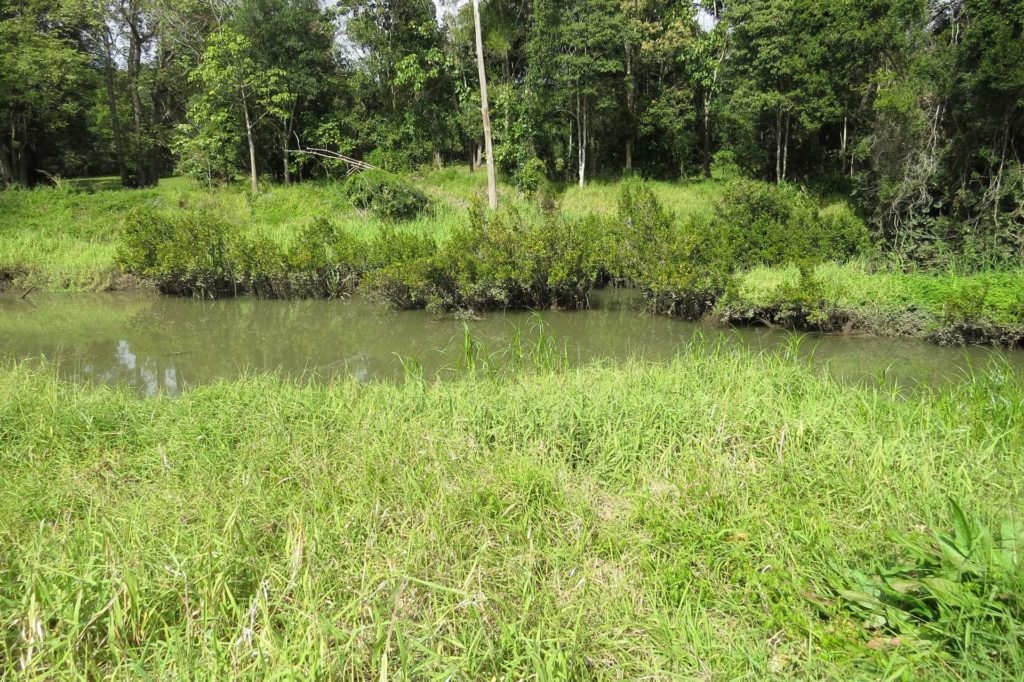Much attention is given to improving the condition of our waterways. Having native vegetation, good water quality and healthy populations of fish and invertebrates in our creeks and rivers is universally agreed to be beneficial, enhancing our natural assets. Lately, some of us who have an eye and ear for native birds have been promoting complementary perspectives.
Biodiversity value is readily apparent in trees and other plants along waterways, and in the conspicuous – or frequently surveyed – animals that they support. But SEQ waterways also harbour inconspicuous, indeed almost invisible, animals that thrive in dense low vegetation. Prevailing climate and native plant communities determine that our wetlands include habitats that humans can barely walk through and generally avoid entering. Thanks to tree clearing, agriculture and urbanisation, the spread of weeds has increased the prevalence of this thick cover along waterways.
At ground and water level, the hidden wildlife of such habitats includes a peculiar group of birds known as crakes and rails. Relatively small in size (from 15 to 33 cm in total length), crakes and rails are less well known than their larger relatives: swamphens, moorhens and coots.
Crakes and rails mainly live in wetland habitats but some range widely outside, for example in thick dry grass or under lantana. Their bodies are laterally compressed, which helps them slip through dense low vegetation like reeds (hence the old expression ‘thin as a rail’).
Preferring to walk or run rather than fly, nonetheless they are capable fliers, some family embers having colonised oceanic islands, others migrating between continents. Where concealing habitat is permanently wet or damp, some crakes and rails can find invertebrate food and nest entirely within that vegetation.
Due to loss of wetlands, changes to habitat structure and predation by cats – but also ignorance of their existence – crakes and rails have declined in range and abundance. In the metropolitan area, Brisbane City Council has designated them as significant species. Its Conservation Action Statement on crakes and rails draws attention to their ecology and provides guidelines for habitat management.

breast band
The largest of this bird group is the beautiful Buff-banded Rail. Probably the best known, it is older than most others and may be seen in the open for short periods, nervously flicking its stubby tail. An opportunist, sometimes it is quite tame in urban parks and gardens, or camp grounds. You may have heard its sharp calls (penetrating short squeaks) in your creek at dawn or dusk.

Second-largest and rather drab, but with a powerful voice, is the Pale-vented Bushhen. Apparently a seasonal visitor in SEQ, it may be revealed in spring-summer by cacophonies of braying, squealing sounds or a long sequence of ‘pook’ (as in ‘look’) notes emanating from your waterway.

venturing out into the open.
The smallest, Spotless Crake, is a shadowy red-eyed bird that also seems to be quarrelling when it emits its signature, fast rattling call. Arguably, the star of the group is the Lewin’s Rail. yet you might never see this red-necked, bar-breasted bird. Exceptionally secretive, Lewin’s Rail nevertheless can be detected from recognition of one of its eight or ten calls. These include fast ‘chit’ sequences, braying trumpet-like notes, soft grunts and ‘raspberry’ sounds (much as children may make, blowing through closed lips), and unusual soft ‘galloping’ sounds. An excited bird may utter several of these in succession!
For conservation and land management in SEQ, Lewin’s Rail is a good indicator of the presence of all four crakes and rails. Better still, in authorised surveys it has proved highly responsive to playback of its calls, frequently replying within a few seconds. Research in south-western suburbs of Brisbane over the past 1.5 years has delivered around 200 records from 80 sites.

weeds, but is great habitat for rails and crakes.
This work has shown that Lewin’s Rail can be found year-round where waterways are permanent. In creeks, it likes areas where water trickles and avoids reaches that are often subject to raging flash floods. Low-set terraces in the waterway bed are favoured, especially along tidal waterways. Rails are at greatest density where habitat is continuous for at least 100 metres and at least 30 metres wide, close to similar blocks of cover, and where the vegetation is very thick. Opportunities to wander under low cover beyond the creek zone may also contribute to their occurrence.
Native plants that provide good habitat for Lewin’s Rail and its allies include Common Reed (Phragmites australis), Bulrush (Typha sp.), Marsh Club-rush (Bolboschoenus fluviatilis), mat-rush (Lomandra spp.), taller beds of Blady Grass (Imperata cylindrica) and mangrove shrubs.
Structure and form are more important for these birds than plant species. Exotic vegetation is commonly, and in some cases it would seem preferentially, inhabited by rails. This includes dense beds of Para Grass (Urochloa mutica) or Mexican Petunia (Ruellia simplex) in wetter zones and Guinea Grass (Megathyrsus maximus var. maximus) in the drier margins. Emergent introduced woody and semi-woody shrubs like Brazilian Pepper (Schinus terebinthifolius) as well as Glycine (Neonotonia wightii) are common elements of rail habitat but may not be the main reason for these birds being present.
Common features of both native and exotic habitats for birds such as Lewin’s Rail are that the vegetation is low (less than 2 metres high) and dense, thereby providing continuously damp or wet substrate and probably limiting predator access.
Landholders and managers of public areas may recognise the existence of rails and other ‘invisible’ birds in their waterways and integrate the requirements of these species in rehabilitation plans. As weeds are a prominent feature of rail habitat, this presents some challenges and possibly adjustments to conventional approaches.
The following guidelines may encourage the occurrence of rails in your waterway:
- Check the waterway for presence of rails and other birds before planning works that will alter existing habitat structure.
- Where possible, consider retaining habitats that presently support rails.
- Encourage the growth of native plant species that support rails.
- Increase the width of linear waterway vegetation and buffer zones by planting native species of low height.
- Avoid cutting back creek-side vegetation, causing the cross-channel width of this zone to gradually decrease;total width of 20 m may be useful but 30 m or more will be far better for rails.
- Avoid channelling the creek or quickening the flow of water: swampy waterways are good for rails.
- If weedy habitat presently inhabited by rails must be replaced by natives, consider alterations in patches and/or replace weedy areas in stages.
- Planting of tall shade trees may eventually exclude rail habitat; to encourage rails, plant trees well back from the water and leave multiple treeless gaps of 30-50 metres along the waterway.
Rehabilitating waterways by planting native forest undoubtedly will benefit forest birds and improve overall condition. Allowing some gaps to remain, where native or weedy low cover can support crakes and rails, will sustain or increase the total biodiversity of the waterway. As a landholder or visitor, you may then be fortunate to enjoy the proclamations and conversations of these invisible and curious creatures.
Further Reading
Brisbane City Council (2014) Crakes and Rails. Conservation Action Statement.
Available from www.brisbane.qld.gov.au
Article and photos by Roger Jaensch
Wetlands and waterbirds conservation specialist, Indooroopilly
